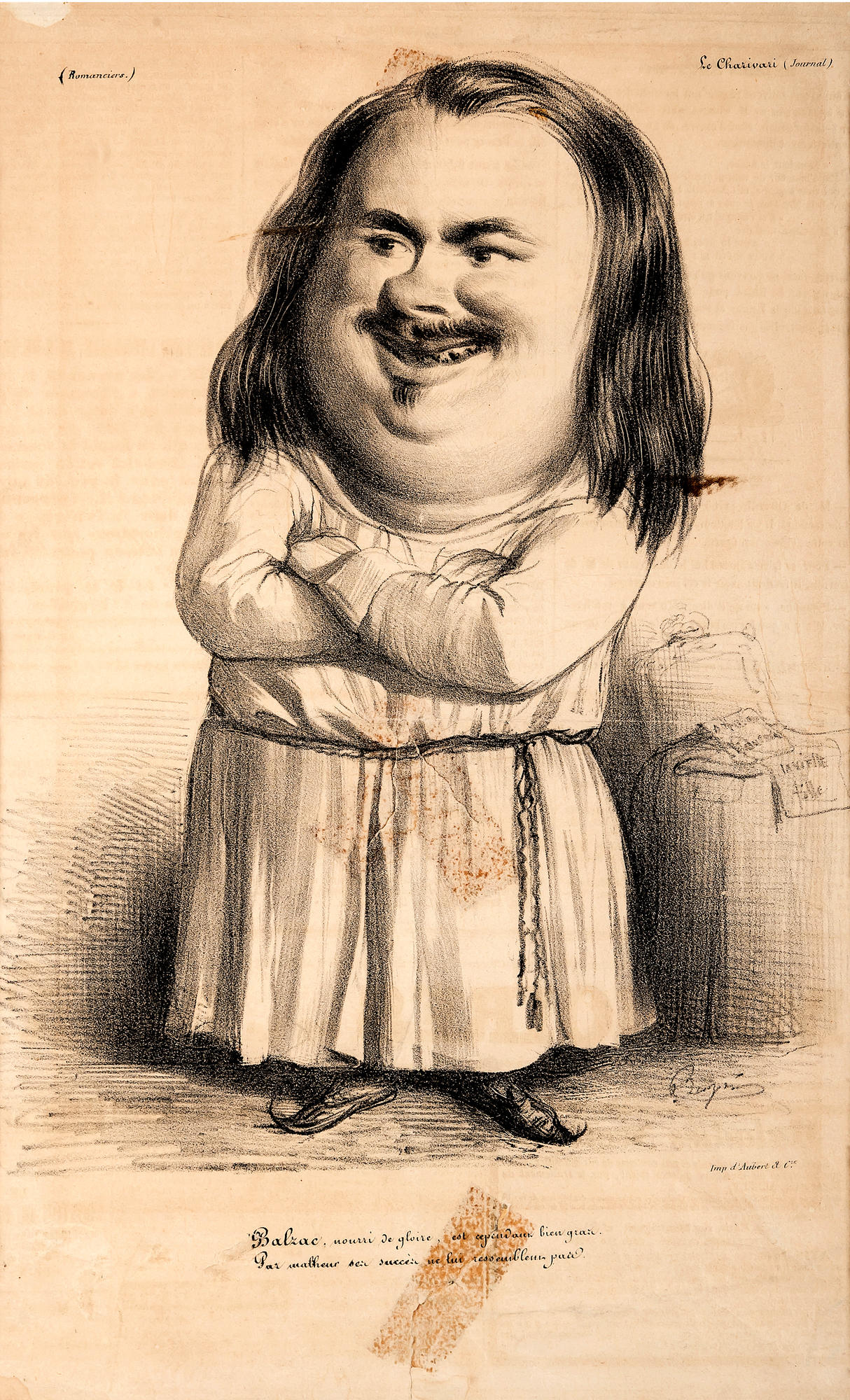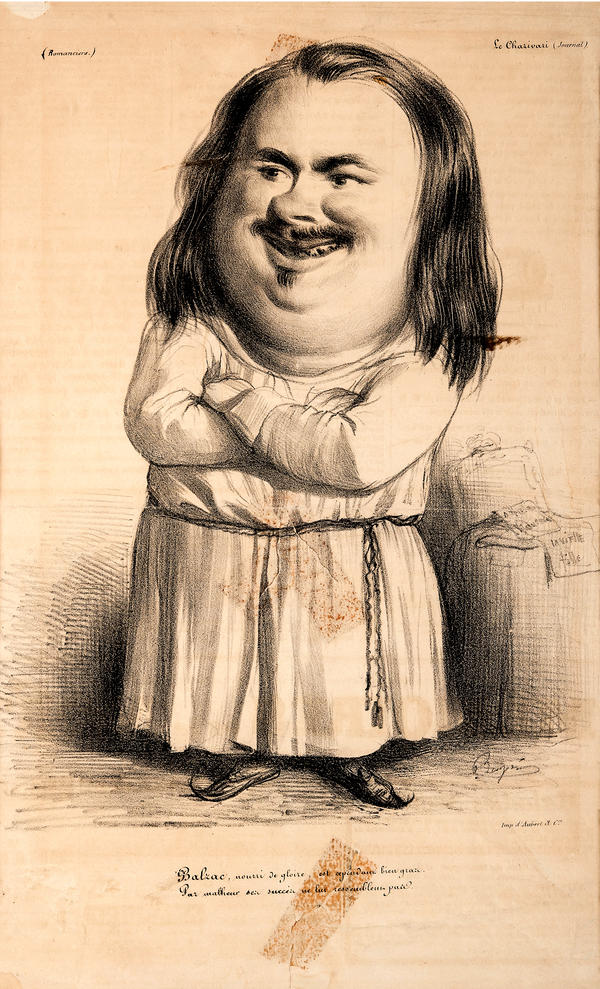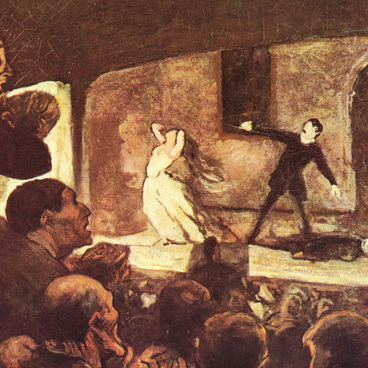This caricature cartoon portrait of the French writer Honoré /ono’re/ de BalzAc (1799-1850) hung in the library of Eisenstein’s PotYlikha apartment, at the bottom of the side of the shelf, to the right of the bedroom door. The author of the cartoon, BenjamIn Roubaud /ru’bo/ (1811–1847), is a renowned cartoonist who worked in the satirical Parisian newspapers La Caricature and Charivari together with Honoré Daumier and Granville since 1830. Roubaud also created “The CharivarI Pantheon”: 100 caricatures of the most influential personalities of his time.
The artist often signed his cartoons simply Benjamin, like on this sheet from the “Charivari” (Le Charivari) newspaper from October 12, 1838. In this lithograph, Roubaud Balzac stands with his arms crossed. He is wearing a robe and house slippers, and sheets of paper with the names of his works lie on the bed. One of the names on these papers is legible: “La vieille fille” (the novel “The Old Maid”, written in 1836). The way he has been depicted here is not accidental: Balzac did not write about exotic countries, romantic adventures, or demonic heroes; but rather about the daily life of modern France and its inhabitants. There is a short poem inscribed under the cartoon: “Balzac, nourri de gloire, est cependant bien gras. Par malheur ses succès ne lui ressemblent pas.” Translated from French, it reads: “Balzac, nourished by glory, is nevertheless very stout. Unfortunately, his successes do not resemble him.”
However, Honoré de Balzac’s fame has endured throughout history. In his grandiose cycle of novels, novellas, and short stories ‘The Human Comedy, ’ he created a collective image of modern society comprising many psychologically and socially accurate portraits of people. Balzac’s works are now considered literary classics, and the development of French and world literature is unimaginable without them.
Eisenstein believed that directors, screenwriters, and actors could learn from Balzac’s expressiveness and imagery when creating their characters. In the director’s theoretical works, there are many references to the writer’s creative experience; Eisenstein gave examples from his works in the classroom with students at the All-Union State Institute of Cinematography. Educational study ‘The Arrest of Vautrin’ based on an episode from Balzac’s novel “Father Goriot” which Eisenstein included in his course became a classic educational tool for understanding the art of mise-en-scène. The film director dreamed of staging the novel “Cousin Betta” in the Moscow Theater of the Revolution, starring his Proletkult student Judith Glieser as the main heroine, but that ambition was never fulfilled.
The artist often signed his cartoons simply Benjamin, like on this sheet from the “Charivari” (Le Charivari) newspaper from October 12, 1838. In this lithograph, Roubaud Balzac stands with his arms crossed. He is wearing a robe and house slippers, and sheets of paper with the names of his works lie on the bed. One of the names on these papers is legible: “La vieille fille” (the novel “The Old Maid”, written in 1836). The way he has been depicted here is not accidental: Balzac did not write about exotic countries, romantic adventures, or demonic heroes; but rather about the daily life of modern France and its inhabitants. There is a short poem inscribed under the cartoon: “Balzac, nourri de gloire, est cependant bien gras. Par malheur ses succès ne lui ressemblent pas.” Translated from French, it reads: “Balzac, nourished by glory, is nevertheless very stout. Unfortunately, his successes do not resemble him.”
However, Honoré de Balzac’s fame has endured throughout history. In his grandiose cycle of novels, novellas, and short stories ‘The Human Comedy, ’ he created a collective image of modern society comprising many psychologically and socially accurate portraits of people. Balzac’s works are now considered literary classics, and the development of French and world literature is unimaginable without them.
Eisenstein believed that directors, screenwriters, and actors could learn from Balzac’s expressiveness and imagery when creating their characters. In the director’s theoretical works, there are many references to the writer’s creative experience; Eisenstein gave examples from his works in the classroom with students at the All-Union State Institute of Cinematography. Educational study ‘The Arrest of Vautrin’ based on an episode from Balzac’s novel “Father Goriot” which Eisenstein included in his course became a classic educational tool for understanding the art of mise-en-scène. The film director dreamed of staging the novel “Cousin Betta” in the Moscow Theater of the Revolution, starring his Proletkult student Judith Glieser as the main heroine, but that ambition was never fulfilled.



